1000+ Cell - the unit of life MCQ for CAT [Solved]
Thursday 9th of March 2023

Sharing is caring
1. Which of the following pair lack the unit membrane?
A. Nucleus and E.R.
B. Mitochondria and chloroplast
C. Ribosome and nucleolus
D. Golgi body and lysosome
Answer : C
A. Nucleus and E.R.
B. Mitochondria and chloroplast
C. Ribosome and nucleolus
D. Golgi body and lysosome
Answer : C
2. Which of the following statements are correct ?
A. (iii) and (iv)
B. (i) and (ii)
C. (ii) and (iii)
D. (i) and (iv)
Answer : A
- In prokaryotic cells, a special membranous structure formed by the extension of the plasma membrane into the cell is known as polysome.
- The smooth endoplasmic reticulum is the major site for synthesis of glycoproteins.
- RuBisCO is the most abundant protein in the whole biosphere.
- Mitochondria, chloroplasts and peroxisomes are not considered as part of endomembrane system. Of the above statements
A. (iii) and (iv)
B. (i) and (ii)
C. (ii) and (iii)
D. (i) and (iv)
Answer : A
3. Which one of the following is not considered as part of the endomembrane system?
A. Golgi complex
B. Peroxisome
C. Vacuole
D. Lysosome
Answer : B
A. Golgi complex
B. Peroxisome
C. Vacuole
D. Lysosome
Answer : B
4. What would happen if lysosomes get ruptured in a cell?
A. Cell dies
B. Cell shrinks
C. Cell swell up
D. Nothing would happen
Answer : A
A. Cell dies
B. Cell shrinks
C. Cell swell up
D. Nothing would happen
Answer : A
5. Which of the following will determines the shape of the cells and provides a strong structural support to prevent the bacterium from bursting or collapsing?
A. Plasmids
B. Cell wall
C. Mesosome
D. Cell membrane
Answer : B
A. Plasmids
B. Cell wall
C. Mesosome
D. Cell membrane
Answer : B
6. In which method of transport, plasma membrane does not require carrier molecule?
A. Active transport
B. Facilitated diffusion
C. Simple diffusion
D. Na+ K+ pump
Answer : C
A. Active transport
B. Facilitated diffusion
C. Simple diffusion
D. Na+ K+ pump
Answer : C
7. Nucleolus is
A. rounded structure found in cytoplasm near nucleus.
B. rounded structure inside nucleus and having rRNA.
C. rod-shaped structure in cytoplasm near the nucleus.
D. none of the above.
Answer : B
A. rounded structure found in cytoplasm near nucleus.
B. rounded structure inside nucleus and having rRNA.
C. rod-shaped structure in cytoplasm near the nucleus.
D. none of the above.
Answer : B
8. Polysome is a chain of
A. oxysomes
B. sphaerosomes
C. ribosomes
D. dictyosomes
Answer : C
A. oxysomes
B. sphaerosomes
C. ribosomes
D. dictyosomes
Answer : C
9. Match column-I (cell organelle) with column-II membrane and select the correct option from the codes given below.
A. A - I, B - II, C - III
B. A - III, B - I, C - II
C. A - III, B - II, C - I
D. A - II, B - III, C - I
Answer : C
| Column-I | Column-II |
|---|---|
| A. Mitochondria | I. Without membrane |
| B. Lysosomes | II. Single membrane |
| C. Ribosomes | III. Double membrane |
A. A - I, B - II, C - III
B. A - III, B - I, C - II
C. A - III, B - II, C - I
D. A - II, B - III, C - I
Answer : C
10. In prokaryotes, chromatophores are
A. specialized granules responsible for colouration of cells
B. structures responsible for organizing the shape of the organism.
C. inclusion bodies lying free inside the cells for carrying out various metabolic activities.
D. internal membrane system which becomes extensive and complex in photosynthetic bacteria.
Answer : D
A. specialized granules responsible for colouration of cells
B. structures responsible for organizing the shape of the organism.
C. inclusion bodies lying free inside the cells for carrying out various metabolic activities.
D. internal membrane system which becomes extensive and complex in photosynthetic bacteria.
Answer : D
11. Identify the components labelled A, B, C and D in the given section of cilia/flagella showing different parts. Choose the option which shows the correct labelling of parts.
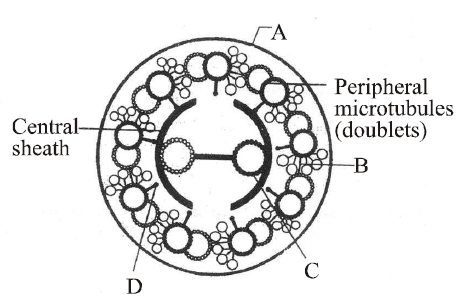
A. A Plasma membrane, B Interdoublet bridge, C Central microtubule, D Radial spoke
B. A Plasma membrane, B Arm, C Central microtubule, D Radial spoke
C. A Plasma membrane, B Interdoublet bridge, C Hub, D Radial spoke
D. A Plasma membrane, B Interdoublet bridge, C Hub, D Arm
Answer : A

A. A Plasma membrane, B Interdoublet bridge, C Central microtubule, D Radial spoke
B. A Plasma membrane, B Arm, C Central microtubule, D Radial spoke
C. A Plasma membrane, B Interdoublet bridge, C Hub, D Radial spoke
D. A Plasma membrane, B Interdoublet bridge, C Hub, D Arm
Answer : A
12. In the given figure of animal cell, one orginelle is marked as A. Select the correct identification and function of the organelle A from the given option.
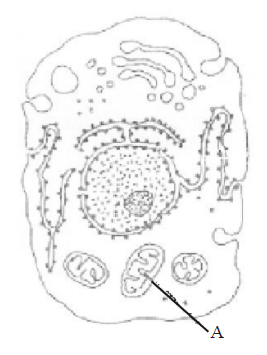
A. Endoplasmic reticulum Synthesis of lipids.
B. Mitochondria Produce cellular energy in the form of ATP.
C. Golgi body Provides packaging material.
D. Lysosomes Secrete hydrolytic enzymes.
Answer : B

A. Endoplasmic reticulum Synthesis of lipids.
B. Mitochondria Produce cellular energy in the form of ATP.
C. Golgi body Provides packaging material.
D. Lysosomes Secrete hydrolytic enzymes.
Answer : B
13. Centrifugation of a cell results in the rupture of the cell membrane and the contents compacting into a pellets in the bottom of the centrifuge tube. Bathing this pellet with a glucose solution yields metabolic activity including the production of ATP. One of the contents of this pellet is most likely which of the following?
A. Cytosol
B. Mitochondria
C. Lysosomes
D. Golgi bodies
Answer : B
A. Cytosol
B. Mitochondria
C. Lysosomes
D. Golgi bodies
Answer : B
14. The best material for study of structure of cell membrane is
A. RBC of human
B. RBC of frog
C. cheek cell of human
D. liver cell of rat
Answer : A
A. RBC of human
B. RBC of frog
C. cheek cell of human
D. liver cell of rat
Answer : A
15. Microtubules are absent in
A. mitochondria
B. centriole
C. flagella
D. spindle fibres
Answer : A
A. mitochondria
B. centriole
C. flagella
D. spindle fibres
Answer : A
16. Grana are
A. protein storing plastids.
B. coloured plastids.
C. stacks of thylakoids.
D. individual thylakoids present in stroma.
Answer : C
A. protein storing plastids.
B. coloured plastids.
C. stacks of thylakoids.
D. individual thylakoids present in stroma.
Answer : C
17. Select the statements which are related to Schwann.
A. Only (i)
B. Only (iii)
C. (i) and (iii)
D. All of these
Answer : D
- He reported that cells have a thin outer layer which is today known as plasma membrane
- Cell wall is a unique character of the plant cell.
- Body of plants and animals are composed of cells and products of cells.
A. Only (i)
B. Only (iii)
C. (i) and (iii)
D. All of these
Answer : D
18. Difference between the prokaryotic and eukaryotic cells in having
A. cell wall
B. nuclear membrane
C. ribosome
D. none of these
Answer : B
A. cell wall
B. nuclear membrane
C. ribosome
D. none of these
Answer : B
19. The following diagram shows some of the missing structures in a plant cell marked as A, B, C, D E. Choose the option with their correct names.
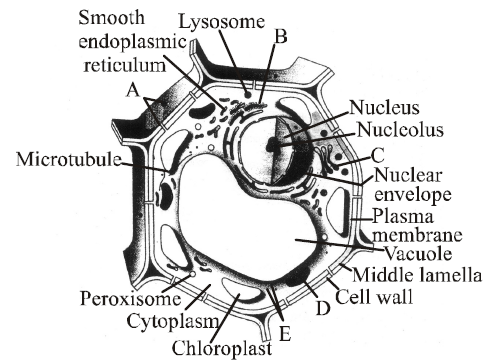
A. A - Plasmodesmata, B - Rough endoplasmic reticulum, C - Golgi apparatus, D - Mitochondrion, E - Ribosomes
B. A - Desmosome, B - Rough endoplasmic reticulum, C - Golgi apparatus, D - Mitochondrion, E - Ribosomes
C. A - Plasmodesmata, B - Smooth endoplasmic reticulum, C - Golgi apparatus, D - Mitochondrion, E - Ribosomes
D. A - Tight junction, B - Rough endoplasmic reticulum, C - Golgi apparatus, D - Mitochondrion, E -Ribosomes
Answer : A

A. A - Plasmodesmata, B - Rough endoplasmic reticulum, C - Golgi apparatus, D - Mitochondrion, E - Ribosomes
B. A - Desmosome, B - Rough endoplasmic reticulum, C - Golgi apparatus, D - Mitochondrion, E - Ribosomes
C. A - Plasmodesmata, B - Smooth endoplasmic reticulum, C - Golgi apparatus, D - Mitochondrion, E - Ribosomes
D. A - Tight junction, B - Rough endoplasmic reticulum, C - Golgi apparatus, D - Mitochondrion, E -Ribosomes
Answer : A
20. Consider the following statements and choose the correct statement.
A. (i) and (iii)
B. (ii) and (iv)
C. (iii) and (iv)
D. (ii) and (iii)
Answer : D
- The endomembrane system includes mitochondria, chloroplast and peroxisomes.
- Smooth endoplasmic reticulum is the major site for synthesis of lipid.
- Rough endoplasmic reticulum is actively involved in protein synthesis.
- Mitochondrial matrix possesses single circular DNA, a few RNA and 80S ribosomes. Of the above statements.
A. (i) and (iii)
B. (ii) and (iv)
C. (iii) and (iv)
D. (ii) and (iii)
Answer : D
21. Which of the following cell organelles were discovered after the introduction of electron microscope?
A. Mitochondria
B. Endoplasmic reticulum
C. Ribosomes
D. Both (b) and (c)
Answer : D
A. Mitochondria
B. Endoplasmic reticulum
C. Ribosomes
D. Both (b) and (c)
Answer : D
22. Lysosomes contain
A. carbohydrates
B. hormones
C. nucleic acids
D. hydrolases.
Answer : D
A. carbohydrates
B. hormones
C. nucleic acids
D. hydrolases.
Answer : D
23. Match column-I with column-II and select the correct option.
A. A - IV, B - V, C - I, D - II
B. A - I, B - II, C - IV, D - III
C. A - IV, B - I, C - II, D - III
D. A - I, B - II, C - III, D - IV
Answer : A
| Column - I | Column - II |
|---|---|
| A. Golgi apparatus | I. Storage |
| B. Mitochondria | II. Photosynthesis |
| C. Vacuoles | III. Transport |
| D. Grana | IV. Secretion |
| .. | V. Respiration |
A. A - IV, B - V, C - I, D - II
B. A - I, B - II, C - IV, D - III
C. A - IV, B - I, C - II, D - III
D. A - I, B - II, C - III, D - IV
Answer : A
24. Plastids are found in
A. all animal cells.
B. some animal cells.
C. all plant cells.
D. all plant cells and euglenoides.
Answer : D
A. all animal cells.
B. some animal cells.
C. all plant cells.
D. all plant cells and euglenoides.
Answer : D
25. Which of the following statements are incorrect ?
A. (i) and (iii)
B. (iii) and (iv)
C. (ii) and (iv)
D. (i) and (iv)
Answer : A
- Plant cells have centrioles which are absent in almost all animal cells.
- Ribosomes are the site of protein synthesis.
- The middle lamella is a layer mainly of calcium carbonate which holds the different neighbouring cells together.
- In animal cell, steroidal hormones are synthesized by smooth endoplasmic reticulum. Of the above statements
A. (i) and (iii)
B. (iii) and (iv)
C. (ii) and (iv)
D. (i) and (iv)
Answer : A
26. The following diagram represents a structure chromosome.
Identify the structures marked as A, B and C.
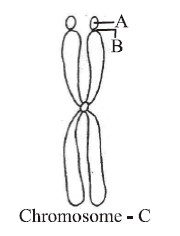
A. A - Satellite, B - Primary constriction, C - Acrocentric
B. A - Satellite, B - Secondary constriction, C - Metacentric
C. A - Satellite, B - Centromere, C - Telocentric
D. A - Satellite, B - Centromere, C - Submetacentric
Answer : B
Identify the structures marked as A, B and C.

A. A - Satellite, B - Primary constriction, C - Acrocentric
B. A - Satellite, B - Secondary constriction, C - Metacentric
C. A - Satellite, B - Centromere, C - Telocentric
D. A - Satellite, B - Centromere, C - Submetacentric
Answer : B
27. pH of vacuolar cell sap is
A. neutral and isotonic.
B. alkaline and isotonic.
C. acidic and hypertonic.
D. equal to cytoplasm and isotonic.
Answer : C
A. neutral and isotonic.
B. alkaline and isotonic.
C. acidic and hypertonic.
D. equal to cytoplasm and isotonic.
Answer : C
28. Match column-I and column-II and select the correct answer
A. A III; B IV; C II; D I
B. A II; B IV; C III; D I
C. A I; B II; C III; D IV
D. A IV; B III; C I ; D II
Answer : B
| Column-I | Column-II |
|---|---|
| A. Bacteria without walls | I. Lysosome |
| B. Small circular DNA | II. Mycoplasma cells |
| C. Flattened sacs in | III. Thylakoid a chloroplast |
| D. A vesicle in which | IV. Plasmid hydrolytic enzymes are stored |
A. A III; B IV; C II; D I
B. A II; B IV; C III; D I
C. A I; B II; C III; D IV
D. A IV; B III; C I ; D II
Answer : B
29. Which of the following statement of a bacterial cell is/are correct?
A. (i), (ii), (iii)
B. All of the above
C. (ii) & (iv)
D. None of the above
Answer : A
- Mesosome is formed by the extensions of plasma membrane into the cell.
- The pili are elongated tubular structures made up of a protein.
- Flagellum is composed of filament, hook and basal body.
- Ribosomes are about 30 nm by 50 nm in size.
A. (i), (ii), (iii)
B. All of the above
C. (ii) & (iv)
D. None of the above
Answer : A
30. Chromosomes having equal or almost equal arms are called
A. metacentric
B. acrocentric
C. polycentric
D. acentric.
Answer : A
A. metacentric
B. acrocentric
C. polycentric
D. acentric.
Answer : A
31. Function of RER is
A. autolysis
B. protein synthesis
C. lipid synthesis
D. carbohydrate synthesis
Answer : B
A. autolysis
B. protein synthesis
C. lipid synthesis
D. carbohydrate synthesis
Answer : B
32. The fluidity of membranes in a plant in cold weather may be maintained by
A. increasing the number of phospholipids with unsaturated hydrocarbon tails.
B. increasing the proportion of integral proteins.
C. increasing concentration of cholesterol in membrane.
D. increasing the number of phospholipids with saturated hydrocarbon tail.
Answer : A
A. increasing the number of phospholipids with unsaturated hydrocarbon tails.
B. increasing the proportion of integral proteins.
C. increasing concentration of cholesterol in membrane.
D. increasing the number of phospholipids with saturated hydrocarbon tail.
Answer : A
33. Read the statements given below with regard to the functions performed by Golgi apparatus ?
Which of the following is the correct answer ?
A. (i) is wrong but (ii) and (iii) are correct
B. (ii) is wrong but (i) and (iii) are correct
C. (ii) and (iii) are wrong but (i) is correct
D. All are correct.
Answer : D
- Transport and chemically modify the materials contained within it.
- Performs the function of packaging materials.
- Important sit of formation of glycoproteins and glycolipids.
Which of the following is the correct answer ?
A. (i) is wrong but (ii) and (iii) are correct
B. (ii) is wrong but (i) and (iii) are correct
C. (ii) and (iii) are wrong but (i) is correct
D. All are correct.
Answer : D
34. Extension of plasma membrane in prokaryotic cell is
A. mesosome
B. haploid
C. ribosome
D. none of these
Answer : A
A. mesosome
B. haploid
C. ribosome
D. none of these
Answer : A
35. The main organelle involved in modification and routing of newly synthesized proteins to their destinations is
A. chloroplast
B. mitochondria
C. lysosome
D. endoplasmic reticulum
Answer : D
A. chloroplast
B. mitochondria
C. lysosome
D. endoplasmic reticulum
Answer : D
36. Which of the following terms is not correctly matched with its feature?
A. Osmosis Movement of water by diffusion.
B. Nucleoplasm Site of active synthesis of ribosomal RNA.
C. Mesosome Infolding of cell membrane and characteristics of eukaryotes.
D. Pili Elongated tubular surface structures (made of special protein) of bacteria.
Answer : C
A. Osmosis Movement of water by diffusion.
B. Nucleoplasm Site of active synthesis of ribosomal RNA.
C. Mesosome Infolding of cell membrane and characteristics of eukaryotes.
D. Pili Elongated tubular surface structures (made of special protein) of bacteria.
Answer : C
37. The best way to identify a cell as either prokaryotic or eukaryotic is to determine whether
A. it came from a single-celled or multicellular organism.
B. it has a nucleus.
C. it has a plasma membrane.
D. it has cytosol.
Answer : A
A. it came from a single-celled or multicellular organism.
B. it has a nucleus.
C. it has a plasma membrane.
D. it has cytosol.
Answer : A
38. You are asked to examine a cell using a powerful light microscope. The image you see has a clearly defined nucleus and mitochondria. It also has a large central vacuole and chloroplasts. From what group of organisms did this cell most likely come?
A. Bacteria
B. Protists
C. Fungi
D. Plants
Answer : D
A. Bacteria
B. Protists
C. Fungi
D. Plants
Answer : D
39. Basal bodies are associated with the formation of
A. phragmoplast
B. cilia and flagella
C. cell plate
D. kinetochore
Answer : B
A. phragmoplast
B. cilia and flagella
C. cell plate
D. kinetochore
Answer : B
40. Which of the following is absent in prokaryotes?
A. DNA
B. RNA
C. Plasma membrane
D. Mitochondria
Answer : D
A. DNA
B. RNA
C. Plasma membrane
D. Mitochondria
Answer : D
41. Which one of the following organelle given below is correctly matched with its function ?
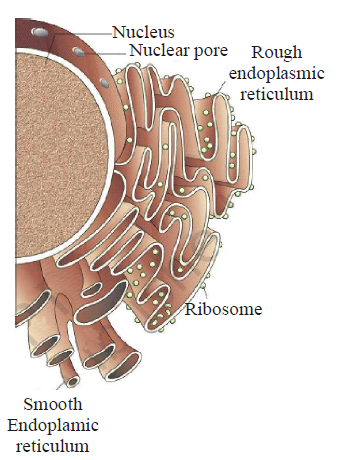
A. Golgi apparatus Protein synthesis
B. Golgi apparatus Formation of glycolipids
C. Rough endoplasmic reticulum Protein synthesis
D. Rough endoplasmic reticulum Formation of glycoproteins
Answer : C

A. Golgi apparatus Protein synthesis
B. Golgi apparatus Formation of glycolipids
C. Rough endoplasmic reticulum Protein synthesis
D. Rough endoplasmic reticulum Formation of glycoproteins
Answer : C
42. Centrioles and centrosomes occur in the cells of
A. green plants
B. animals
C. bacteria and cyanobacteria
D. both (b) and (c)
Answer : B
A. green plants
B. animals
C. bacteria and cyanobacteria
D. both (b) and (c)
Answer : B
43. _______________ is the important site of formation of glycoproteins and golycolipids.
A. SER
B. Lysosome
C. Golgi apparatus
D. Mitochondria
Answer : C
A. SER
B. Lysosome
C. Golgi apparatus
D. Mitochondria
Answer : C
44. Integral proteins of cell membrane occur on/in
A. inner surfaces
B. outer surfaces
C. phospholipid matrix
D. inner and outer surfaces
Answer : D
A. inner surfaces
B. outer surfaces
C. phospholipid matrix
D. inner and outer surfaces
Answer : D
45. Golgi apparatus is concerned with
A. excretion
B. secretion
C. ATP synthesis
D. RNA synthesis
Answer : A
A. excretion
B. secretion
C. ATP synthesis
D. RNA synthesis
Answer : A
46. The given figures show two types of cell. Which structures are common to both the cells?

A. Nucleus and cell wall
B. Nucleus and cytoplasm
C. Ribosomes and flagella
D. Ribosomes and cell wall
Answer : D

A. Nucleus and cell wall
B. Nucleus and cytoplasm
C. Ribosomes and flagella
D. Ribosomes and cell wall
Answer : D
47. An organalle devoid of membrane covering is
A. vacuole
B. ribosome
C. peroxisome
D. lysosome
Answer : B
A. vacuole
B. ribosome
C. peroxisome
D. lysosome
Answer : B
48. Which of the following statement is correct regarding vacuole?
A. It is membrane-bound and contains storage proteins and lipids.
B. It is membrane-bound and contains water and excretory substances.
C. It lacks membrane and contains air.
D. It lacks membrane and contains water and excretory substances.
Answer : B
A. It is membrane-bound and contains storage proteins and lipids.
B. It is membrane-bound and contains water and excretory substances.
C. It lacks membrane and contains air.
D. It lacks membrane and contains water and excretory substances.
Answer : B
49. Which of the following is incorrect ?
A. Mycoplasma is the smallest cell (0.3 �).
B. Bacteria are 3 to 5 �m in size.
C. The largest cell is the egg of an ostrich.
D. Nerve cells are some of the smallest cells.
Answer : D
A. Mycoplasma is the smallest cell (0.3 �).
B. Bacteria are 3 to 5 �m in size.
C. The largest cell is the egg of an ostrich.
D. Nerve cells are some of the smallest cells.
Answer : D
50. Which of the following is not the function of cell wall?
A. Only (i)
B. Only (iv)
C. Only (ii), (iii) and (iv)
D. None of the above
Answer : D
- Provides shape to the cell.
- Protects the cell from mechanical damage and infection.
- Helps in cell to cell interaction.
- Provides barrier to undesirable macromolecules.
A. Only (i)
B. Only (iv)
C. Only (ii), (iii) and (iv)
D. None of the above
Answer : D
Sharing is caring
Related Post
1000+ Machine Design Multiple Choice Question Answer [Solved]
RRB ALP - Structural Organization In Animals 1000+ MCQ [Solved] PDF Download
1000+ Advance DBMS Multiple Choice Question Answer [Solved]
1000+ Asp Programming MCQ for SSC Scientific Assistant [Solved]
1000+ Current Affairs October 2022 MCQ for JEE Main [Solved]
1000+ The Living World Multiple Choice Question Answer [Solved]